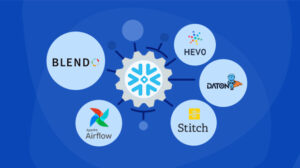Data extraction is the process of acquiring data from a given source and transferring it to a new setting, either on-premises, in the cloud, or a combination of the two. There are several procedures applied for this purpose, which might be sophisticated and are frequently carried out manually. Unless data is extracted primarily for archiving purposes, it is often the initial phase of the Extraction, Transformation, and Loading (ETL) process. This implies that after initial retrieval, data always requires further processing to make it usable for subsequent analysis. Despite the availability of extremely important data, one survey discovered that businesses disregard up to 43 percent of available data. Worse still, just 57 percent of the data they do gather gets utilized. Why is this a cause for alarm?
Without the ability to extract all data kinds, even those that are poorly structured and unorganized, organizations cannot maximize the value of information and make the best decisions. Working with a high-quality dataset is essential to ensuring that your machine learning model works effectively; therefore, choosing a reliable data extraction technique might provide many advantages for your operations. In this article, we will define data extraction and explore the primary obstacles that organizations face during the process. In addition, we will discuss the most common data extraction tools and provide potential alternatives.
What exactly is ETL
ETL is a data integration procedure that integrates data from various data sources into a single, consistent data store that is put into a data warehouse or other destination system.
ETL was created as a procedure for integrating and loading data for calculation and analysis in the 1970s, later becoming the dominant method for processing data in data warehousing initiatives as databases gained prominence.
ETL serves as the basis for data analytics and machine learning workflows. Through a set of business rules, ETL cleanses and organizes data to suit business intelligence requirements, such as monthly reporting, but it may also address more complex analytics, which can enhance back-end operations or end-user experiences. ETL is frequently employed by organizations to:
- Retrieve information from older systems
- Purge the data to enhance data quality and ensure consistency.
- Load data into a target database
ETL tools
Historically, companies created their own ETL code. There are already a variety of open source and commercial ETL tools and cloud services available. These products have the following functionalities as standard:
- Leading ETL technologies automate the complete data flow, from data sources to the destination data warehouse, with an emphasis on usability. Numerous programs recommend guidelines for data extraction, transformation, and loading.
- This capability may be used to specify rules and data flows through a visual, drag-and-drop interface.
- This includes aid with intricate computations, data integrations, and string manipulations.
- Security and conformity: The top ETL tools encrypt data both in transit and at rest and are certified HIPAA and GDPR compliant.
- In addition, many ETL solutions have developed to accommodate the integration of real-time and streaming data for artificial intelligence (AI) applications and feature ELT
Why is Data Extraction Important
At some time, most businesses in most sectors will need to extract data. As part of a bigger move to a cloud platform for data storage and administration, the requirement arises for many enterprises. For others, data extraction is crucial for modernizing databases, integrating systems following an acquisition, or unifying data between business divisions. Organizations utilize automated data extraction systems to
Make prudent choices
Enterprises start by swiftly obtaining raw data from essential sources to get business insight for quicker, better decision-making.
Concentrate workers on high-value tasks
Manual methods are very labor-intensive and expensive in terms of the human resources required. With automated data extraction methods, firms reduce the administrative strain on IT personnel, enabling them to focus on higher-value work.
Minimize error
Manual data entry by employees inevitably results in incomplete, erroneous, and duplicate information. By using automated data extraction technologies, businesses may eliminate inaccuracies in their mission-critical data.
Increase productivity
Manual data input is not only time-consuming and error-prone, but also a repetitious activity that many staff dislike. Many firms believe that allowing employees to concentrate on their primary responsibilities and more strategic tasks is a benefit to individual and overall productivity, as well as beneficial for business.
Types Of Data Extraction
Data Extraction jobs can be scheduled by data analysts or on-demand based on business needs and applications. Data can be extracted in three different ways:
Update Notification
Data extraction can easily be done from any data source; only the system needs to issue a notification when a record is altered. Most databases have a mechanism for data modification and database replication. Several SaaS applications also provide webhooks, which offer similar features.
Incremental Extraction
Few data sources are unable to provide notification when the data is modified, but they can identify records which have been updated and provide data extracts. During the following ETL steps, the data extraction code needs to classify and deliver updates. One limitation of incremental extraction is that it is unable to identify deleted records in source data as there is no means to do it.
Full Extraction
Full extraction is the process that one has to follow during his first data extraction. Few data sources do not have a system to identify modified records so reloading a whole database remains to be the only method to get source data. Full extraction involves high data transfer volumes and puts a higher load on the network; hence this process is not recommended.
How is The Data Extraction Process Performed
The data extraction process from any data source, such as a SaaS platform or a database involves the following steps:
- Identify the modified structure of the data, which can be the addition of new columns, tables. Updated data structures should be handled programmatically.
- Fetch the required fields and tables from the source data specified by the data replication scheme.
- Retrieve the correct data.
Data extracted from any source is loaded into a destination that supports data analysis and BI reporting. Popular cloud data warehouses are Microsoft Azure SQL, Amazon Redshift, Snowflake and Google BigQuery.
Data Types can be extracted using Data Extraction
Corporations extract two sorts of data:
Unstructured Data
Unstructured data are not saved in a database format that is standardized or structured. There is an abundance of both human- and machine-generated unstructured data. Typical types of Internet-of-Things data include audio, email, geospatial, sensor, and surveillance information (IoT). To extract unstructured data, businesses must first execute data preparation and cleaning operations such as eliminating duplicate results, removing unnecessary symbols, and establishing how to handle missing information.
Structured Data
Structured data is maintained within a transactional system in a defined manner. Structured data includes the rows of a SQL database table. When dealing with structured data, businesses often extract the data inside the source system. Companies can extract a large array of organized and unstructured data to satisfy their business requirements. However, the retrieved data often falls into three categories:
- Operational Data
Numerous firms harvest data pertaining to normal actions and procedures to get a deeper understanding of results and increase operational efficiency. - Customer Information
For marketing and advertising purposes, businesses frequently collect consumer names, contact information, purchase histories, and other details. - Financial Data
Companies may track performance and execute strategic planning with the use of measures such as sales figures, acquisition costs, and prices of competitors.
Learn in detail about Unstructured Data vs Structured Data.
Types of Data Extraction Tools
Tools for extracting data include:
Iterative Processing
Tools for batch processing extract data in big, aggregated chunks. Because they need a great deal of computing power, these technologies frequently do data extraction during a business’s off hours.
Open Source
Open-source technologies, which are often offered for free, might be a suitable option for organizations with a limited budget and sufficient IT competence to utilize the tools efficiently.
Cloud-based
The most recent generation of cloud-based solutions excels in quick, automated data extraction. Typically installed as part of a wider cloud ETL solution, these platforms enable businesses to take advantage of scalable storage and analytics while offloading security and regulatory worries.
Examples of Data Extraction
There are several instances of data extraction, but some of the most frequent include extracting data from a database, a web page, or a document.
Web Scraping
Web scraping is the extraction of information from websites. It is a type of data mining that may be used to acquire data from sources that would be difficult or impossible to access otherwise. Web scraping may be utilized to collect price information, contact information, and product information, among many other things. It is necessary for data-driven firms and may be utilized to make educated pricing, product development, and marketing decisions.
Data Mining
Data mining is the extraction of valuable information from vast data collections. It is essential because it enables organizations to make more informed decisions by gaining a deeper knowledge of their consumers and their data.
Data Warehouse
The significance of data warehouses is that they enable organizations to combine data from many sources into one data destination. This facilitates data access, analysis, and data sharing with other applications.
Future of Data Extraction
The development of cloud computing and storage has had a profound effect on how businesses and organizations handle their data. In addition to innovations in data protection, storage, and processing, the cloud has made the ETL process more adaptable and efficient than ever before. Without maintaining their own servers or data infrastructure, organizations may now access and analyze data from around the globe in real time. Increasing numbers of businesses are transferring data away from traditional on-premises systems and towards hybrid and cloud-native data options.
The Internet of Things is thus transforming the data landscape (IoT). In addition to cell phones, tablets, and computers, wearables like Fitbit, automobiles, home appliances, and even medical equipment are rapidly providing data. Once the data has been extracted and transformed, the outcome is an ever-increasing volume of data that may be utilized to drive a company’s competitive edge.
This article presented the concept of Data Extraction as well as its need. In addition, you were provided with an overview of the various forms of Data Extraction and the fundamental distinctions between Full Extraction and Incremental Extraction. Finally, you were shown a hypothetical example of how incorporating Data Extraction might improve a company’s business process.
Challenges with Data Extraction
The most frequent obstacles to data extraction operations, particularly when they are a component of the ETL system, include:
- Coherence of data derived from diverse sources, particularly when the sources are both organized and unstructured. AI-based data extraction technologies can be trained to compile data in a manner suited for post-processing processes.
- In data extraction applications, data security is a further area that might be difficult. Financial data, for example, are extremely sensitive, and firms that utilize automated data input technologies for data management must assure data protection.
Conclusion
If a business is prepared for big data processing, there are several methods for gleaning vital insights from its vast data sets, but the sheer volume of data streaming through a normal digital ecosystem can be intimidating. It is crucial to have a reliable partner to obtain the finest possible outcomes from that data.
Numerous data entry platforms, such as Daton our eCommerce-focused Data Pipeline, have comprehensive technical assistance staff that may aid with overcoming obstacles and maximizing the potential of automated data enter processes. Intelligent document processing use cases from Daton facilitate organizations’ adoption of automation. Here are a few noteworthy case studies:
- 95 percent of time spent on manual data input is saved via Daton
- Daton automation enables Advantage Marketing to grow their firm fivefold.
Saras Analytics connects data sources across your cloud, on-premises, or hybrid environment and supports the ETL data transformation procedures necessary to cleanse, store, and integrate that data into analytics platforms. Saras Analytics does the arduous integration work and enhances how your organization manages its data, therefore priming your data integration processes to provide more insightful insights.
Learn how an integration platform can assist your data migration and ETL tools and help your organization obtain end-to-end business visibility from a valuable resource you already own – the data that is moving across your business ecosystem.












